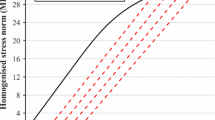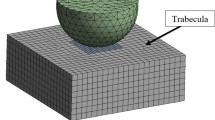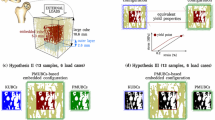Abstract
Using the three-dimensional morphological data provided by computed tomography, finite element (FE) models can be generated and used to compute the stiffness and strength of whole bones. Three-dimensional constitutive laws capturing the main features of bone mechanical behavior can be developed and implemented into FE software to enable simulations on complex bone structures. For this purpose, a constitutive law is proposed, which captures the compressive behavior of trabecular bone as a porous material with accumulation of irreversible strain and loss of stiffness beyond its yield point and softening beyond its ultimate point. To account for these features, a constitutive law based on damage coupled with hardening anisotropic elastoplasticity is formulated using density and fabric-based tensors. To prevent mesh dependence of the solution, a nonlocal averaging technique is adopted. The law has been implemented into a FE software and some simple simulations are first presented to illustrate its behavior. Finally, examples dealing with compression of vertebral bodies clearly show the impact of softening on the localization of the inelastic process.
Similar content being viewed by others
References
Bažant ZP, Cedolin L (1991) Stability of structures. Oxford University Press, New York and Oxford
Bažant ZP, Jirásek M (2002) Nonlocal integral formulations of plasticity and damage: survey of progress. J Eng Mech ASCE 128: 1119–1149
Boutroy S, Van Rietbergen B, Sornay-Rendu E, Munoz F, Bouxsein ML, Delmas PD (2008) Finite element analysis based on in vivo hr-pqct images of the distal radius is associated with wrist fracture in postmenopausal women. J Bone Miner Res 23(3): 392–399
Chevalier Y, Charlebois M, Pahr D, Varga P, Heini P, Schneider E, Zysset P (2008a) A patient-specific finite element methodology to predict damage accumulation in vertebral bodies under axial compression, sagittal flexion and combined loads. Comput Methods Biomech Biomed Eng 11(5): 477–487
Chevalier Y, Pahr D, Charlebois M, Heini P, Schneider E, Zysset P (2008b) Cement distribution, volume, and compliance in vertebroplasty: some answers from an anatomy-based nonlinear finite element study. Spine 33(16): 1722–1730
Chevalier Y, Pahr DH, Zysset PK (2008c) Anatomy and morphology-based smooth finite element models of human vertebral bodies. In: 16th Annual symposium on computational methods in orthopaedic biomechanics, San Francisco, California, March 1st, 2008
Crawford RP, Cann CE, Keaveny TM (2003) Finite element models predict in vitro vertebral body compressive strength better than quantitative computed tomography. Bone 33(4): 744–750
Cristofolini L, Juszczyk M, Martelli S, Taddei F, Viceconti M (2007) In vitro replication of spontaneous fractures of the proximal human femur. J Biomech 40(13): 2837–2845
Curnier A, He Q-C, Zysset P (1995) Conewise linear elastic materials. J Elast 37(1): 1–38
Eswaran SK, Gupta A, Adams MF, Keaveny TM (2006) Cortical and trabecular load sharing in the human vertebral body. J Bone Miner Res 21(2): 307–314
Eswaran SK, Gupta A, Keaveny TM (2007) Locations of bone tissue at high risk of initial failure during compressive loading of the human vertebral body. Bone 41(4): 733–739
Fondrk MT, Bahniuk EH, Davy DT (1999a) A damage model for nonlinear tensile behavior of cortical bone. J Biomech Eng 121(5): 533–541
Fondrk MT, Bahniuk EH, Davy DT (1999b) Inelastic strain accumulation in cortical bone during rapid transient tensile loading. J Biomech Eng 121(6): 616–621
Garcia D, Zysset P, Charlebois M, Curnier A (2009) A three-dimensional elastic plastic damage constitutive law for bone tissue. Biomech Model Mechanobiol 8: 149–165
Gibson LJ, Ashby MF (1999) Cellular solids: structure and properties. Cambridge University Press, Cambridge
Grassl P, Jirásek M (2006a) Damage-plastic model for concrete failure. Int J Solids Struct 43(22–23): 7166–7196
Grassl P, Jirásek M (2006b) Plastic model with non-local damage applied to concrete. Int J Numer Anal Methods Geomech 30(1): 71–90
Green AE, Naghdi PM (1965) A general theory of an elastic-plastic continuum. Springer, Berlin
Hansen NR, Schreyer HL (1994) A thermodynamically consistent framework for theories of elastoplasticity coupled with damage. Int J Solids Struct 33(3): 359–389
Hayes WC, Carter DR (1976) Postyield behavior of subchondral trabecular bone. J Biomed Mater Res 10(4): 537–544
Imai K, Ohnishi I, Matsumoto T, Yamamoto S, Nakamura K (2009) Assessment of vertebral fracture risk and therapeutic effects of alendronate in postmenopausal women using a quantitative computed tomography-based nonlinear finite element method. Osteoporos Int 20(5): 801–810
Jirásek M, Patzák B (2002) Consistent tangent stiffness for nonlocal damage models. Comput Struct 80(14–15): 1279–1293
Kachanov LM (1986) Introduction to continuum damage mechanics. Springer, Berlin
Keaveny TM, Donley DW, Hoffmann PF, Mitlak BH, Glass EV, San Martin JA (2007) Effects of teriparatide and alendronate on vertebral strength as assessed by finite element modeling of qct scans in women with osteoporosis. J Bone Miner Res 22(1): 149–157
Keaveny TM, Morgan EF, Niebur GL, Yeh OC (2001) Biomechanics of trabecular bone. Annu Rev Biomed Eng 3: 307–333
Lemaitre J, Chaboche J-L (1994) Mechanics of solid materials. Cambridge University Press, Cambridge
Lubarda VA, Krajcinovic D (1995) Some fundamental issues in rate theory of damage-elastoplasticity. Int J Plas 11(7): 763–797
Macneil JA, Boyd SK (2008) Bone strength at the distal radius can be estimated from high-resolution peripheral quantitative computed tomography and the finite element method. Bone 42(6): 1203–1213
Matsuura M, Eckstein F, Lochmüller E-M, Zysset PK (2008) The role of fabric in the quasi-static compressive mechanical properties of human trabecular bone from various anatomical locations. Biomech Model Mechanobiol 7(1): 27–42
Maugin GA (1992) The Thermomechanics of plasticity and fracture. Cambridge University Press, Cambridge
Melton LJ, Riggs BL, van Lenthe GH, Achenbach SJ, Müller R, Bouxsein ML, Amin S, Atkinson EJ, Khosla S (2007) Contribution of in vivo structural measurements and load/strength ratios to the determination of forearm fracture risk in postmenopausal women. J Bone Miner Res 22(9): 1442–1448
Natali AN, Carniel EL, Pavan PG (2008a) Constitutive modelling of inelastic behaviour of cortical bone. Med Eng Phys 30(7): 905–912
Natali AN, Carniel EL, Pavan PG (2008b) Investigation of bone inelastic response in interaction phenomena with dental implants. Dent Mater 24(4): 561–569
Pahr D, Zysset P (2009) From high-resolution ct data to finite element models: development of an integrated modular framework. Comput Methods Biomech Biomed Engin 12(1): 45–57
Patzák B, Bittnar Z (2001) Design of object oriented finite element code. Adv Eng Softw 32(10–11): 759–767
Pistoia W, van Rietbergen B, Lochmller E-M, Lill CA, Eckstein F, Regsegger P (2002) Estimation of distal radius failure load with micro-finite element analysis models based on three-dimensional peripheral quantitative computed tomography images. Bone 30(6): 842–848
Prendergast P (1997) Finite element models in tissue mechanics and orthopaedic implant design. Clin Biomech 12(6): 343–366
Rakotomanana L, Curnier A, Leyvraz F (1991) An objective anisotropic elastic plastic model and algorithm applicable to bone mechanics. Eur J Mech Solid 10(3): 327–342
Rincón-Kohli L, Zysset P (2009) Multi-axial mechanical properties of human trabecular bone. Biomech Model Mechanobiol 8(3): 195–208
Simo JC, Hughes TJR (2000) Computational Inelasticity. Interdisciplinary Applied Mathematics. Springer, corrected edition
Simo JC, Taylor RL (1985) Consistent tangent operators for rate-independent elastoplasticity. Comput Methods Appl Mech Eng 48(1): 101–118
Verhulp E, van Rietbergen B, Müller R, Huiskes R (2008) Indirect determination of trabecular bone effective tissue failure properties using micro-finite element simulations. J Biomech 41(7): 1479–1485
Zysset P (1994) A constitutive law for trabecular bone. PhD thesis, EPFL, Lausanne
Zysset P, Curnier A (1995) An alternative model for anisotropic elasticity based on fabric tensors. Mech Mater 21(4): 243–250
Zysset PK, Curnier A (1996) A 3d damage model for trabecular bone based on fabric tensors. J Biomech 29(12): 1549–1558
Zysset P, Rincón L (2006) Mechanics of biological tissue., Chapter an alternative fabric-based yield and failure criterion for trabecular bone. Springer, Berlin, pp, pp 457–470
Zysset PK (2003) A review of morphology-elasticity relationships in human trabecular bone: theories and experiments. J Biomech 36(10): 1469–1485
Author information
Authors and Affiliations
Corresponding author
Rights and permissions
About this article
Cite this article
Charlebois, M., Jirásek, M. & Zysset, P.K. A nonlocal constitutive model for trabecular bone softening in compression. Biomech Model Mechanobiol 9, 597–611 (2010). https://doi.org/10.1007/s10237-010-0200-3
Received:
Accepted:
Published:
Issue Date:
DOI: https://doi.org/10.1007/s10237-010-0200-3




